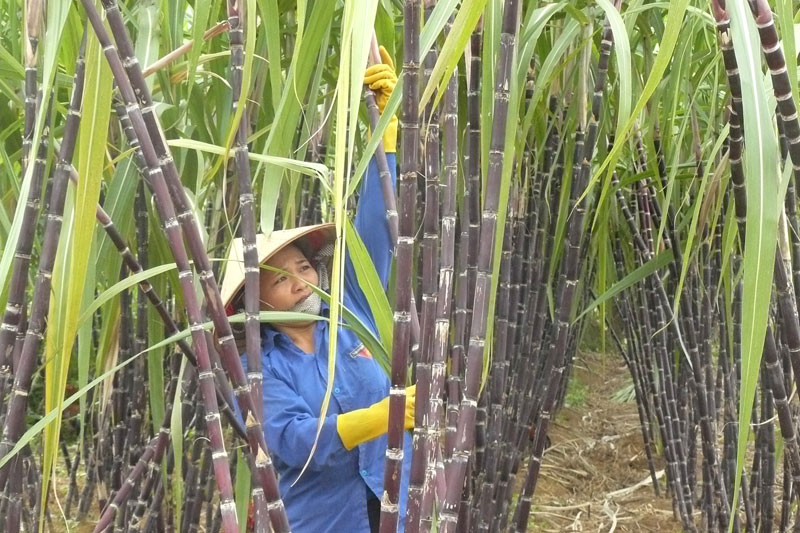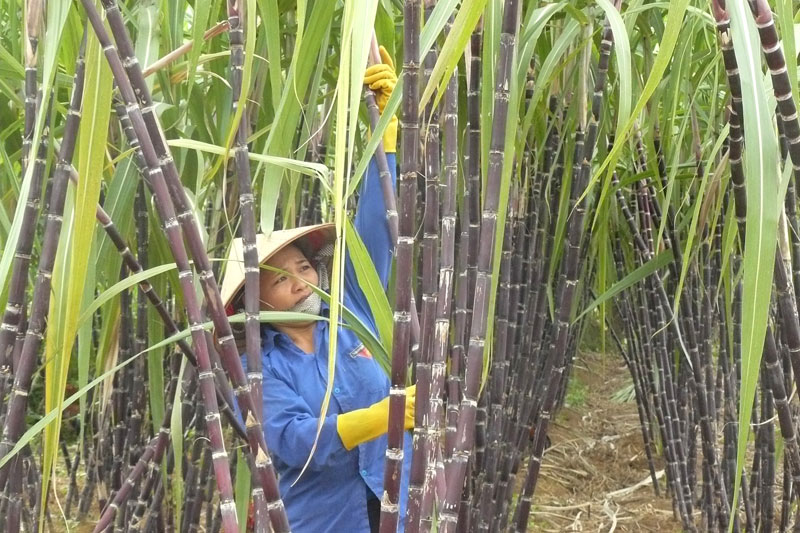
HBO – Sugarcane has brought about a high economic value and had a stable consumer market compared with other crops. Sugarcane has become a key crop in the local cultivation industry, contributing 17 – 18 percent of Hoa Binh province's agricultural production value.
The
province is carrying out an investment project to develop its purple sugarcane
brand in Cao Phong, Tan Lac, Lac Son, Yen Thuy and Kim Boi districts with a
total area of about 1,760 ha.
The
26.4 billion VND (1.13 million USD) project aims to develop concentrated
sugarcane production areas. Planning of purple sugarcane production is also an
important part in implementing the agricultural restructuring project towards
improving the added value and sustainable development of Hoa Binh province by
2020.

Tan My commune (Lac Son district)
grows purple sugarcane, earning around 150 million VND per hectare.
In
2018, the province's sugarcane productivity reached about 71 tonnes per
hectare, making up a total output of 549,487 tonnes. The sugarcane production
value surpassed 1.3 trillion VND. The average growth rate of sugarcane
production in the 2011-2018 period is 99.23 percent a year. The average income
of sugarcane growers is about 200-250 million VND a hectare, of which spending
is about 100-110 million VND per hectare, and profit of about 100-140 million
VND per hectare. The sugarcane (purple and white sugarcane) growing area always
accounts for a high proportion in the province's sugarcane planting area (from
80-85 percent).
Vice
Chairman of the provincial People’s Committee Nguyen Van Dung said that the
committee assigned the local Department of Agriculture and Rural Development to
review and adjust the sugarcane production planning until 2020 with a vision to
2030 in the key districts of Lac Son, Tan Lac, Yen Thuy, Da Bac and Lac Thuy. Accordingly,
the purple sugarcane area will be raised to 9,500 hectares by 2020, and 10,000
hectares by 2030, with the sugarcane output reaching about 225,000 tonnes.
According
to him, it is necessary to focus on implementing solutions on science and
technology, mechanisms and policies, credit, and encouraging the application of
mechanisation in sugarcane production, and encouraging enterprises to invest in
agriculture and rural areas.
Attention
should be paid to investing in building and expanding sugarcane establishments
of the centre for plant varieties, livestock and fisheries, and the Hoa Binh
Sugarcane joint Stock Company, he said, adding that the province strives to use
100 percent of sugarcane varieties to be produced by tissue culture by 2025./.
According to data from the Hoa Binh Provincial Party Committee, the industrial production index for the first six months of 2025 is estimated to have increased by 20% compared to the same period last year. This marks the highest year-on-year growth rate for this period since 2020.
In the first six months of 2025, Hoa Binh province’s export turnover was estimated at 1.145 billion USD, marking an 18.11% increase compared to the same period in 2024. Import turnover was estimated at $ 804 million, a 17.15% increase, which helped the province maintain a positive trade balance.
The lives of the ethnic minority farmers in Tan Lac district have gradually improved thanks to the new directions in agricultural production. This is a testament to the collective strength fostered through the professional associations and groups implemented by various levels of the district’s Farmers’ Union.
With the motto the "product quality comes first,” after nearly one year of establishment and operation, Muong village’s Clean Food Agricultural and Commercial Cooperative, located in Cau Hamlet, Hung Son Commune (Kim Boi district), has launched reputable, high-quality agricultural products to the market that are well-received by consumers. The products such as Muong village’s pork sausage, salt-cured chicken, and salt-cured pork hocks have gradually carved out a place in the market and they are on the path to obtaining the OCOP certification.
In the past, the phrase "bumper harvest, rock-bottom prices" was a familiar refrain for Vietnamese farmers engaged in fragmented, small-scale agriculture. But today, a new spirit is emerging across rural areas of Hoa Binh province - one of collaboration, organisation, and collective economic models that provide a stable foundation for production.
Maintaining growing area codes and packing facility codes in accordance with regulations is a mandatory requirement for agricultural products to be eligible for export. Recently, the Department of Agriculture and Environment of Hoa Binh province has intensified technical supervision of designated farming areas and packing facilities to safeguard the "green passport" that enables its products to access international markets.



